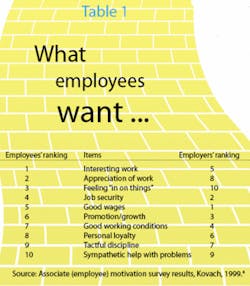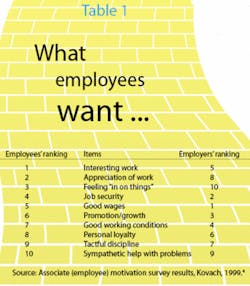Lions and Tigers and Bears ... Oh My!
How fear of the “big things” can distract us from the danger right under our nose
by Jackie Bailey
Dorothy Gale, from the Warner Bros. classic The Wizard of Oz,1 was a sweet young lady from Kansas. She survived a virtual whirlwind that left her in an unfamiliar environment. Alone and frightened, she was forced to head down an unfamiliar path on her journey toward an important goal.
Early on in her adventure, Dorothy discovered friends willing to help her - individuals seeking their own fulfillment and success. Dorothy and her friends decided that working together would provide the greatest chance for all to be happy and achieve their desires. It wasn’t long until Dorothy and her friends began to fear that dangerous animals could be lurking in the dark forests that lined the path.
“Lions and tigers and bears, oh, my!” the friends chanted, as though speaking them aloud would somehow ward off the danger. Their fears were realized, and their strengths were challenged. But Dorothy soon discovered that what she imagined was her greatest threat turned out to be one of her closest and dearest companions - a lion.
Dorothy shouldn’t have worried so much about lions, tigers and bears, because there was a plot being hatched by the Wicked Witch of the West. The Wicked Witch said as she cast her spell, “... Something with poison in it, I think ... but attractive to the eye and soothing to the smell ... poppies, poppies will put them to sleep.”
Dorothy let her guard down, left the yellow-brick road, and was lulled to sleep by those poppies. Just as the Emerald City came into view, Dorothy’s journey was halted. If only she had been more careful.
Sometimes dentists are like Dorothy. They can become complacent and lulled to sleep, so to speak, when they aren’t careful. Sometimes, just when the Emerald City is in view, contentment from conquering the “big things” turns to regret upon discovering that they weren’t considerate enough of the “small things.” A dentist’s journey can be altered by changes in the everyday, insignificant things. Sometimes a dentist considers his or her team to be insignificant.
Althea Gibson,2 a pioneer in both amateur tennis and professional golf, overcame unbelievable odds to find success in her own journey. She grew up on the violent streets of Harlem, but revealed her strength on the courts of Wimbledon. In 1957, she was the first black to be voted Female Athlete of the Year by the Associated Press.
Althea once said, “No matter what accomplishments you make, somebody helped you.”
Dentists are very intelligent individuals. They have spent years in school learning their craft. Upon opening a practice, the dentist becomes owner, president, manager, and every other employee in the business. It then becomes difficult to relinquish control of business matters as staff hiring begins.
No matter how difficult it may be to let go, it is imperative that a dentist’s main focus be on practicing dentistry. And it is even more important for dentists to understand that they cannot accomplish all they want without the help of many people.
Hiring team members and then not allowing them to help the practice succeed is similar to Dorothy letting her guard down and allowing the narcotic effect of those poppies to keep her from reaching her goal. When a dentist focuses more on collection, production, marketing, or overhead than on the quest to be the best he or she can be clinically, the dentist can actually undermine the success of collection, production, marketing, and overhead. Hiring the best people and then allowing them to do their best is the real secret to success in a dental practice.
Far too often, employees feel unappreciated because the dentist tries to maintain too much control. Team members who believe that their contributions don’t matter, or aren’t important, will find a position at another practice that will allow them to feel valued. The cost of turnover is far too high, but the solution can be very simple.
In July 2002, Ian Bessell, Brad Dicks, Allen Wysocki, and Karl Kepner published an article titled Understanding Motivation: An Effective Tool for Managers.3 Although not written specifically for dentistry, the principles they taught may be applied appropriately for dentistry if the dentist is considered a manager.
The authors say, “Motivation is an important tool that is often underutilized by managers (dentists) today. Motivation used to inspire people ... will produce the best results in the most efficient and effective manner.”3
Bessell and his colleagues suggest that the manager identify individual motivating factors for each team member. Finding out what makes each person tick may sound overwhelming, but the power of this simple courtesy goes a long way. People tend to do their best work when they are in an environment where they feel valued, where they get a pat on the back or a thank you for a job well done.3
The “platinum rule” is that you should do unto others as they would have you do unto them.3
A study, published in 1999 by Kenneth Kovach of George Mason University, compared what employees wanted from their jobs with what their bosses thought was important to their employees.4 The results of the study were ranked by priority and were somewhat surprising. See Table 1.
When trying to understand team members, dentists must consider the fact that the career status of employees will vary. For instance, staff members nearing the end of their careers might appreciate being given mentoring responsibilities or more control of their work environment, while mid-career staff members might appreciate flexible scheduling options and professional development opportunities. Employees early in their career might need immediate praise to boost their confidence. According to Kovach,4 dentists should ask themselves the 10 questions in Table 2 when attempting to provide a more positive motivational climate for associates.
Glinda, the Good Witch of the North, saved Dorothy and her friends by causing snow to fall in the Land of Oz. The deep freeze caused them to awaken before it was too late. But how did Glinda find out that help was needed? The Scarecrow and the Tin Man were unaffected by the poisonous poppies, and they called for help. It will take both brains and heart, like our two heroes, to change the priorities of a dental practice.
If you’re a dentist who has lost valuable employees because you feared the lions, tigers, and bears, then it’s time to get back on track. Keep your eye on the Emerald City, consider the poppies (team members) in your practice, and appreciate the beauty and color they provide. But don’t allow yourself to be so distracted by your journey that you trample on them. Give your employees freedom to add fun and variety to your practice, and they’ll add the aroma of success that will help you sleep better - at night, that is.
Jackie Bailey is president of Emerald City Consulting in Sammamish, Wash. Contact her at [email protected], (425) 894-3424, or www.emeraldcityconsulting.com.
Table 2
Questions to ask when trying to provide motivational climate ...
- Do you personally thank staff for a job well done?
- Is feedback timely and specific?
- Do you make time to meet with - and listen to - staff on a regular basis?
- Is your workplace open, trusting, and fun?
- Do you encourage and reward initiative and new ideas?
- Do you share information about your organization with staff on a regular basis?
- Do you involve staff in decisions, especially those that will affect them?
- Do you provide staff with a sense of ownership of their jobs and the unit as a whole?
- Do you give associates the chance to succeed?
- Do you reward staff members based on their performance?
References
1 Warner Bros. Studios. The Wizard of Oz. 2006. Retrieved Dec. 1, 2006 from http://thewizardofoz.warnerbros.com/.
2 Althea Gibson (2007) Retrieved June 21, 2007, from http://www.altheagibson.com/.
3 Bessell I, Dicks B, Wysocki A, Kepner K. Understanding motivation: An effective tool for managers; EDIS document HR 017, a publication of the Department of Food and Resource Economics, Florida Cooperative Extension Service, Institute of Food and Agricultural Sciences, University of Florida, Gainesville, Fla. 2002. Retrieved June 21, 2007, from http://edis.ifas.ufl.edu.
4 Kovach K. Employee motivation: Addressing a crucial factor in your organization’s performance. Human Resource Development. Ann Arbor, Mich. 1999. University of Michigan Press.

